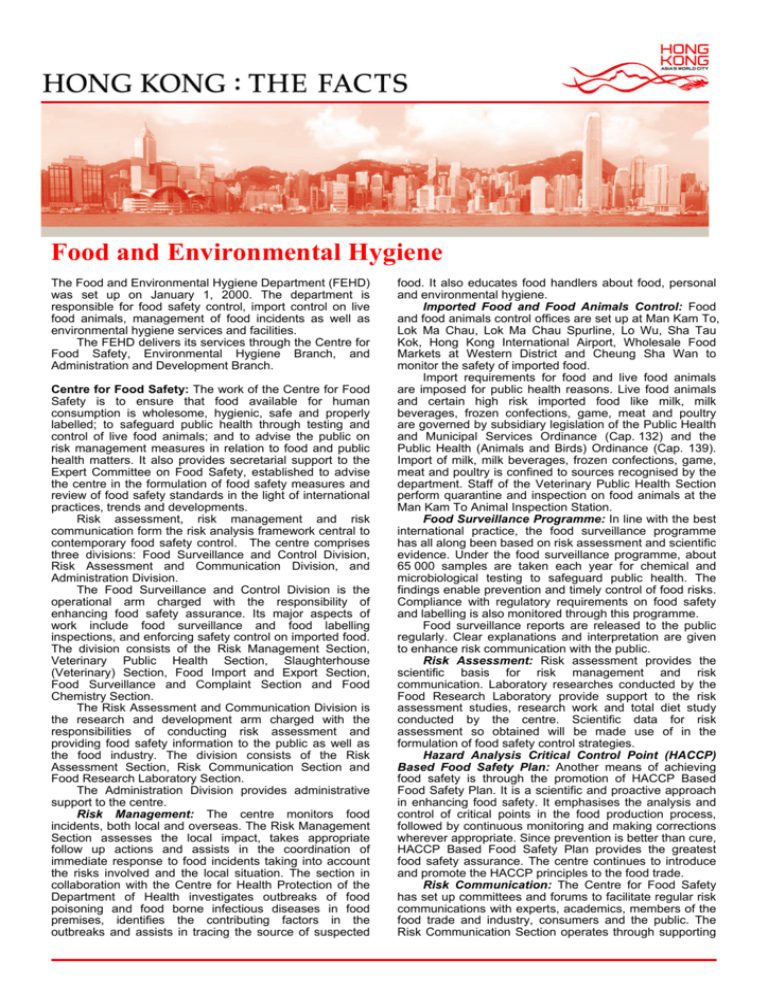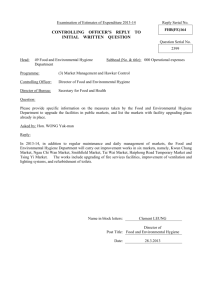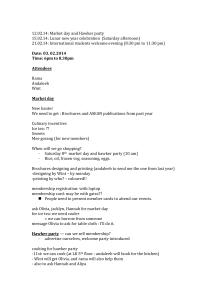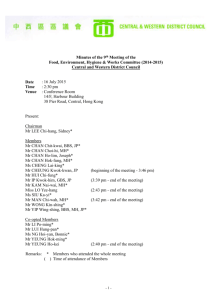Food and Environmental Hygiene
advertisement

HONG KONG : THE FACTS HONG KONG : THE FACTS Food and Environmental Hygiene The Food and Environmental Hygiene Department (FEHD) was set up on January 1, 2000. The department is responsible for food safety control, import control on live food animals, management of food incidents as well as environmental hygiene services and facilities. The FEHD delivers its services through the Centre for Food Safety, Environmental Hygiene Branch, and Administration and Development Branch. Centre for Food Safety: The work of the Centre for Food Safety is to ensure that food available for human consumption is wholesome, hygienic, safe and properly labelled; to safeguard public health through testing and control of live food animals; and to advise the public on risk management measures in relation to food and public health matters. It also provides secretarial support to the Expert Committee on Food Safety, established to advise the centre in the formulation of food safety measures and review of food safety standards in the light of international practices, trends and developments. Risk assessment, risk management and risk communication form the risk analysis framework central to contemporary food safety control. The centre comprises three divisions: Food Surveillance and Control Division, Risk Assessment and Communication Division, and Administration Division. The Food Surveillance and Control Division is the operational arm charged with the responsibility of enhancing food safety assurance. Its major aspects of work include food surveillance and food labelling inspections, and enforcing safety control on imported food. The division consists of the Risk Management Section, Veterinary Public Health Section, Slaughterhouse (Veterinary) Section, Food Import and Export Section, Food Surveillance and Complaint Section and Food Chemistry Section. The Risk Assessment and Communication Division is the research and development arm charged with the responsibilities of conducting risk assessment and providing food safety information to the public as well as the food industry. The division consists of the Risk Assessment Section, Risk Communication Section and Food Research Laboratory Section. The Administration Division provides administrative support to the centre. Risk Management: The centre monitors food incidents, both local and overseas. The Risk Management Section assesses the local impact, takes appropriate follow up actions and assists in the coordination of immediate response to food incidents taking into account the risks involved and the local situation. The section in collaboration with the Centre for Health Protection of the Department of Health investigates outbreaks of food poisoning and food borne infectious diseases in food premises, identifies the contributing factors in the outbreaks and assists in tracing the source of suspected food. It also educates food handlers about food, personal and environmental hygiene. Imported Food and Food Animals Control: Food and food animals control offices are set up at Man Kam To, Lok Ma Chau, Lok Ma Chau Spurline, Lo Wu, Sha Tau Kok, Hong Kong International Airport, Wholesale Food Markets at Western District and Cheung Sha Wan to monitor the safety of imported food. Import requirements for food and live food animals are imposed for public health reasons. Live food animals and certain high risk imported food like milk, milk beverages, frozen confections, game, meat and poultry are governed by subsidiary legislation of the Public Health and Municipal Services Ordinance (Cap. 132) and the Public Health (Animals and Birds) Ordinance (Cap. 139). Import of milk, milk beverages, frozen confections, game, meat and poultry is confined to sources recognised by the department. Staff of the Veterinary Public Health Section perform quarantine and inspection on food animals at the Man Kam To Animal Inspection Station. Food Surveillance Programme: In line with the best international practice, the food surveillance programme has all along been based on risk assessment and scientific evidence. Under the food surveillance programme, about 65 000 samples are taken each year for chemical and microbiological testing to safeguard public health. The findings enable prevention and timely control of food risks. Compliance with regulatory requirements on food safety and labelling is also monitored through this programme. Food surveillance reports are released to the public regularly. Clear explanations and interpretation are given to enhance risk communication with the public. Risk Assessment: Risk assessment provides the scientific basis for risk management and risk communication. Laboratory researches conducted by the Food Research Laboratory provide support to the risk assessment studies, research work and total diet study conducted by the centre. Scientific data for risk assessment so obtained will be made use of in the formulation of food safety control strategies. Hazard Analysis Critical Control Point (HACCP) Based Food Safety Plan: Another means of achieving food safety is through the promotion of HACCP Based Food Safety Plan. It is a scientific and proactive approach in enhancing food safety. It emphasises the analysis and control of critical points in the food production process, followed by continuous monitoring and making corrections wherever appropriate. Since prevention is better than cure, HACCP Based Food Safety Plan provides the greatest food safety assurance. The centre continues to introduce and promote the HACCP principles to the food trade. Risk Communication: The Centre for Food Safety has set up committees and forums to facilitate regular risk communications with experts, academics, members of the food trade and industry, consumers and the public. The Risk Communication Section operates through supporting these regular communication forums, organising various events and functions, producing publications and various forms of training and community resource materials, and conducting other communication activities for building up and maintaining a trusting and constructive tripartite relationship with the public and the trade. It also operates the Communication Resource Unit (CRU) in Fa Yuen Street Municipal Services Building which has a collection of resource materials on food safety for public reference. The Unit organises various programmes to promote food safety and use of nutrition labelling and provides lending service for audio-visual learning/teaching aids to organisations and schools. Environmental Hygiene Branch: The Environmental Hygiene Branch is responsible for the implementation and co-ordination of environmental hygiene services, management of public markets, hawker control and licensing matters. The branch consists of a Headquarters Division and three Operations Divisions. The Headquarters Division is responsible for formulating departmental policies and guidelines on environmental hygiene services, licensing, market management and hawker control. It advises the Liquor Licensing Board on liquor licensing matters and provides secretarial support to the board. It also processes applications for review to the appeal boards. The three Operations Divisions are responsible for monitoring and management of environmental hygiene services in all districts throughout Hong Kong. Public Cleansing: The FEHD provides cleansing services, including street sweeping, household waste collection and other cleansing work, by both the in-house workforce and cleansing contractors involving a total of about 10 800 frontline operatives. For achieving greater efficiency and cost-effectiveness, the department has continued to contract out public cleansing services. At present, 74 per cent of household waste collection service and 77 per cent of manual street cleansing service have been outsourced. All streets are manually swept at least once every day. In the main commercial and tourist areas, streets are swept for an average of four times a day, and up to eight times a day in the busiest pedestrian areas. In addition to manual sweeping, there are seven mechanical sweepers from the FEHD contractor responsible for the cleaning of highways, flyovers and central dividers. FEHD and cleansing contractors have a total of 97 street washing vehicles which operate day and night with the frequency of street washing ranging from on need basis to daily depending on the nature of the area served. On gully emptying, the FEHD maintains both inhouse staff and contractor’s fleet to operate seven gully emptying vehicles to provide regular service. The FEHD and its contractors operate a total of 237 modern refuse collection vehicles. Every day, about 5 390 tonnes of household waste are collected from over 3 160 FEHD refuse collection points and bin sites and other collection points in residential estates all over the territory. They are taken to the refuse transfer stations or landfills managed by the Environmental Protection Department (EPD). In line with the Government’s policy to collect recyclable items for recycling, the FEHD provides recyclables collection service for the 2 869 sets of recyclables collection bins provided in schools, government clinics, public places and various venues under its purview as well as that of the Water Supplies Department and EPD. Each set of the bins comprises individual compartments for the collection of waste paper, metal and plastic materials. Public Toilets: Altogether 785 public toilets come under the department and about 32 per cent of the toilets with high usage rate are provided with toilet attendants. In addition, there are 62 aqua privies in the New Territories and outlying islands. In order to upgrade old public toilets to the latest standard of provision, the FEHD has embarked on a toilet refurbishment programme. So far, 272 projects have been completed. To improve the sanitary condition of aqua privies, the FEHD implemented a programme to convert aqua privies into flushing toilets by phases starting from 2005. Final phase of the conversion programme was completed by the end of 2014 and a total of 441 aqua privies have been converted to flushing toilets. Enforcement: The Government enforces against common cleanliness offences (i.e. littering, spitting, unauthorised display of bills or posters and fouling of street by dog faeces) by issuing fixed penalty notices of $1,500 to offenders. A “zero tolerance” approach is adopted in the enforcement. Food and Other Trades: The FEHD is the licensing authority for food businesses (namely restaurants, food factories, bakeries, fresh provision shops, factory canteens, siu mei and lo mei shops, frozen confection factories, milk factories, cold stores, composite food shops and sale of restricted foods), certain trades (namely places of public entertainment, commercial bathhouses, private swimming pools, funeral parlours, undertaker businesses, slaughterhouses and offensive trades) and karaoke establishments operating in restaurants in Hong Kong. The FEHD performs regular inspections to licensed and permitted premises to ensure that licence and permit holders comply with licensing requirements and conditions as well as the law. As at the end of 2014, there were 31 557 licensed and permitted food premises, 1 555 licensed other trade premises and 84 karaoke establishments in restaurants. Public Markets: As at the end of 2014, the FEHD operates a total of 76 public markets and 25 free standing cooked food markets, with around 14 400 stalls selling foodstuffs and a whole range of clothing and daily necessities. The department is vested with the responsibility of properly managing these markets and keeping these markets tidy. Promotions are also conducted in selected markets to improve their business environment. To enhance the vibrancy of public markets, the FEHD has introduced service trades, snack shops and bakeries to certain markets with vacant stalls since mid-2009. At the end of 2014, 117 service trade stalls, seven snack stalls and one bakery stall were let out. Hawker Control: The FEHD is responsible for hawker management and control in Hong Kong. There are, in essence, two categories of hawker licences: fixed-pitch hawker licences and itinerant hawker licences. As at the end of 2014, the number of fixed-pitch and itinerant hawker licences were 5 644 and 219 respectively in the urban area, and 261 and 223 respectively in the New Territories. Hawker Control Teams are deployed to control illegal hawking activities and to minimise nuisances created by street trading either by hawkers or by illegal extension of shops into the street area. Assistance Scheme for Hawkers in Fixed-pitch Hawker Areas: Since the launch of the five-year “Assistance Scheme for Hawkers in Fixed-pitch Hawker Areas” in June 2013 to provide financial assistance to 4 300 hawkers in the 43 fixed-pitch hawker areas to reduce fire risks in hawker areas, the FEHD has worked out relocation plans with all fixed-pitch hawkers whose stalls may obstruct fire escape staircase exits or emergency operations, involving about 500 fixed pitches. Including hawker licences surrendered, 56 per cent of these hawker pitches have been vacated. Up to the end of 2014, the FEHD has received 1 060 applications for relocation and reconstruction grants, and 356 hawkers have surrendered their licences. Slaughterhouses: The FEHD is responsible for the monitoring of slaughterhouses to ensure that their operations meet the required hygiene and environmental standards. There are three licensed slaughterhouses, namely Sheung Shui Slaughterhouse, Tsuen Wan Slaughterhouse and Cheung Chau Slaughterhouse, with a total daily throughput of about 4 686 pigs, 51 cattle and 14 goats. Veterinary officers deployed to work in the slaughterhouses are responsible for the monitoring of the health condition of food animals and the examination of drug residues. While field officers stationed at the slaughterhouses conduct body fluid and tissue sampling of food animals for testing and perform ante-mortem inspection, health inspectors inspect food animals after slaughtering; monitor the operation of slaughterhouses and arrangement of meat delivery, etc., so as to ensure only meat fit for human consumption is released for sale in the market. Pest Control: Pest control work, such as the control of rodents, mosquitoes and other arthropod pests with medical importance, is carried out by both the FEHD in-house and contractor pest control teams. It aims to prevent and control the breeding of disease vectors. The methodology in pest control is continuously reviewed to ensure effectiveness and efficacy in controlling the disease vectors. The Pest Control Advisory Section provides professional advice on the prevention and control of public health pests to government departments and the public. Cemeteries and Crematoria: The FEHD serves the public by providing services on cremation and burial of body and skeletal remains. It operates six government crematoria, 10 public cemeteries and eight public columbaria, and oversees the management of 27 private cemeteries. In addition to the above traditional burial services, the FEHD also promotes sustainable ways of handling cremains by encouraging the public to scatter ashes of their ascendants in its 11 Gardens of Remembrance or at designated Hong Kong waters. It also provides the Internet Published by the Information Services Department, Hong Kong Special Administrative Region Government GovHK Website: http://www.gov.hk Information contained in this publication may be freely used. No acknowledgement is necessary. Memorial Service website and its mobile version for the public to pay tribute to the deceased and to show condolence to their lost loved ones at any time and from anywhere. Administration and Development Branch: The Administration and Development Branch is responsible for departmental administration, including staff management and development, financial management, information technology, planning and implementation of capital works projects, outsourcing of services, complaints management, public information and public education. Health Education: The FEHD is responsible for the promotion of food safety and environmental hygiene. It operates the Health Education Exhibition and Resource Centre (HEERC) in Kowloon Park. The HEERC comprises a 1 100-square-metre exhibition area, a 400-square-metre outdoor health education garden, a resource centre holding a collection of over 4 500 items of publications and a lecture room. The HEERC supports a wide range of health education services including holding public exhibitions and talks, and providing publications and audio-visual materials for reference. Public Education and Publicity: Public education and publicity play an important role in the FEHD’s activities and initiatives, forming part of an integrated approach to ensuring food safety and improving environmental hygiene. Messages promoting “Keep Clean”, “Food Safety”, “Salt and Sugar Reduction”, “Anti-rodent” and “Anti-mosquito” are disseminated through various channels, such as television and radio Announcements in the Public Interest, posters and banners, pamphlets and leaflets, departmental website, outreach programmes, school talks, seminars, workshops, exhibitions, Mobile Exhibition Centre (a publicity vehicle), etc. Educational and publicity efforts are also directed at various target groups, e.g. members of the food trade, students, the elderly, etc. Food and Environmental Hygiene Department Home Page address: http://www.fehd.gov.hk March 2015







